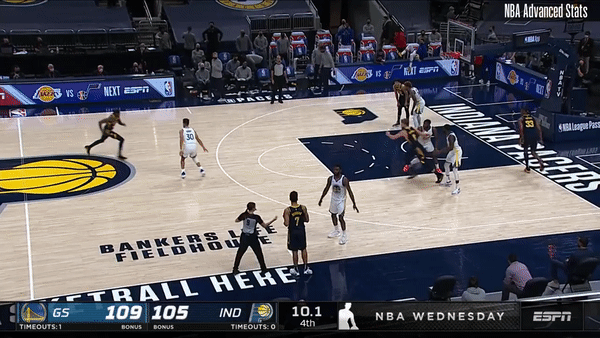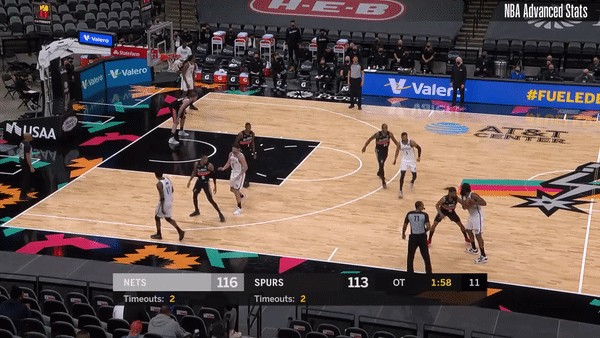This week’s jumbled bag is of a set of end-of-game moments, usually a fun time to see what go-to plays teams turn to and how their opponents react.
Spanish Steps
The Charlotte Hornets stunned the Sacramento Kings by coming back from 8 points down with about a minute to go on Sunday night. On the game-winning after timeout (ATO) play, Coach James Borrego had the Hornets run a stack pick and roll (frequently called a “Spain pick and roll”; Jordan Cummings had a good explanation with video a few years ago.) To recap, the offense typically has three personnel: (A) the ballhandler, (B) a screener setting the initial pick, typically a big, and (C) a shooter who sets a back screen on the screener’s defender. The Hornets ran this with LaMelo Ball (A), PJ Washington (B), and Malik Monk (C). With the other two Hornets spacing the floor in the corners, Monk ultimately finished the play with an and-one make at the rim.
Off the inbounds, PJ Washington screens LaMelo’s man De’Aaron Fox while Malik Monk sets the back screen on Washington’s man Richaun Holmes. Monk pops out beyond the arc after setting the back screen, with his man Cory Joseph in hot pursuit.
Spain pick and rolls can be tricky to defend because they require all three defenders (not to mention the other two defenders, depending on what the offense ultimately runs) in the play to communicate and work together; any breakdown and the shooter could have an open three, the ballhandler could have an open lane to the basket, or the roller could get free. The Kings are far and away the worst defense in the league this season, giving up nearly 120 points per 100 possessions, and are ripe for the type of defensive breakdown that Spain pick and rolls are primed to exploit.
The Kings don’t switch this action and do reasonably well sticking with their men until Monk beats Joseph off the dribble. My biggest quibble is with Fox’s positioning here; he is initially in good position to help off of LaMelo on Monk’s drive.
He subsequently both backs off and opens up his body to open up the lane for Monk.
This is compounded when Washington pops out to the arc and Fox doesn’t dig in at all; it’s hard to fault Richaun Holmes for following Washington, who was 5-8 from 3 point range on the game (nearly 39% on the season) as he racked up a career-high 42 points. By the time Holmes realizes that he is the last line of defense, it’s too late and he is leaning in the wrong direction.
Final notes on this one as we replay the gif: Ball and Washington execute their choreography well, first faking a Washington roll before Washington pops, sending Holmes every which way.
A fun set, executed well, and the Hornets come away with the win.
Pacers-Warriors
After losing late-game leads against both the Charlotte Hornets and the Orlando Magic on their recent east coast swing, the Golden State Warriors ground out wins against the New York Knicks and the Indiana Pacers. Let’s look at one of the game-sealing plays at the end of the Pacers game. With the Pacers inbounding after a timeout, down 4 with 10 seconds left, the initial alignment had me expecting a Domantas Sabonis pin down for Doug McDermott to pop out for a 3 at the top of the arc. The play ultimately looked sloppy, with Sabonis and Kelly Oubre Jr. crashing to the ground as Draymond Green came away with the steal. Here it is in its entirety:
That end belies how much came before, so here are From The Logo’s notes from this play:
It looks like the Pacers might actually have wanted to engineer a switch for Sabonis and go for the quick two here. The first Sabonis screen looks like either misdirection, or a bid to get Steph Curry switched on to him. Steph fights over the screen to stay with his man and Sabonis sprints into the pin down for McDermott.
Oubre is right up on McDermott to try and deny him any separation coming off the screen.
Nevertheless, Sabonis flattens Oubre on the screen and the Warriors switch. Eric Paschall switches from Sabonis on to McDermott and denies the initial inbound pass from Malcolm Brogdon.
McDermott is quick to point Brogdon towards the Sabonis mismatch inside; this might be the original option, or McDermott pivoting out of the initial hope to get him a good look up top. Caitlin Cooper has written about how McDermott is an astute reader of when to pivot during plays like this (sidebar: Cooper is one of my favorite basketball writers out there and should be a must read, even for non-Pacers fans.)
Sabonis accidentally smacks Oubre in the face and Oubre falls (or flops, depending on how cynical you are) and that’s that. Now go back and watch Draymond Green for the entirety of the play.
Draymond is locked in on the main action and does not follow Myles Turner’s cut along the baseline to the opposite corner, recognizing it as a decoy. He stays middle to play a free safety role, recognizing that he may be needed to help on a Sabonis mismatch.
Draymond two-nines to remain in close help position (ultimately rendered moot, but still allowing him to get the steal.)
If you are keeping track, that’s all five Warriors players (including Wiggins on the inbounder) recognizing and playing their roles very competently. Little things like this add up and help explain why the Warriors have flirted with a top-five defense all season long.
Draymond Brown
Going in to Monday’s night’s game against the Spurs, the Brooklyn Nets hadn’t won a regular season game in San Antonio since 2002 (well in the New Jersey Nets days.) The last game the team had won in San Antonio came in the 2003 NBA Finals. I have cynically taken to writing these games off as a schedule loss for the Nets, but as they hung on to a double-digit lead with two minutes to go and the Spurs missing a number of good players, it seemed time for the streak to finally end. The streak did end, but the Nets needed to do it in overtime.
The Spurs blitzed Kyrie Irving and James Harden at the end of regulation and the Nets were clearly unprepared. First, DeAndre Jordan turned it over after Kyrie passed out of the double team.
Following a three from Nets-killer Patty Mills, it was Harden’s turn to pass out of the double team and Kyrie coughed up an ill advised pull-up three.
Kyrie is shooting 38% on pull-up threes this season and this isn’t a terrible look, but there were better options out there. I like Bruce Brown in the triple threat position, available for Kyrie on the pass if Joe Harris is a little harder to reach. From there, Brown could either kick it out to a wide-open Harris on the left wing (54.7% on catch and shoot 3s this season!), or draw Jakob Poeltl’s help to open up Jordan for the dunk.
A DeMar DeRozan drive and Dejounte Murray hail mary sent this to OT. Shout out the Nets for recognizing where their offense came up short at the end of regulation and making the right reads in OT. First, Kyrie is sharp in passing immediately out of the double team to Brown for the 3.
More importantly, recognizing that the Spurs were blitzing Harden and Kyrie at the top of the arc, the Nets hoisted the Spurs on their own petard. Here, after going up to set a high screen for Harden, Brown slips and does his best Draymond Green impression in a 4-on-3 to find Kyrie for the corner three. As the roll man, Brown is scoring 1.27 points per possession on the season and if he continues to display this sort of decision making, it bodes well for the burgeoning Brown-Harden pick and roll.
Next play down, the Nets run a similar play, only this time Joe Harris is filling the strong side corner and Dejounte Murray is in a tough single-side tag situation. Bruce Brown is shooting 51% in that 3-10 feet floater range on the season and he seals the game.
Oftentimes it isn’t a single ATO at the end of the game, but a series of late game adjustments that end up being the difference.




















